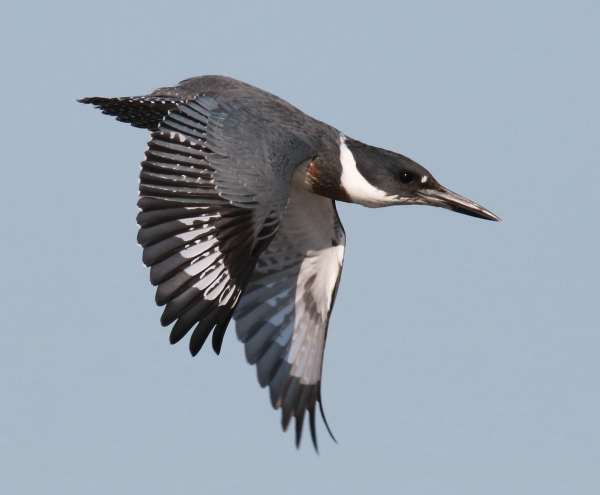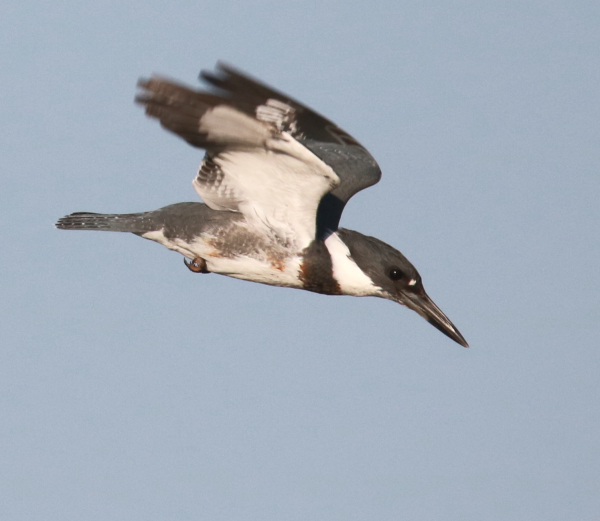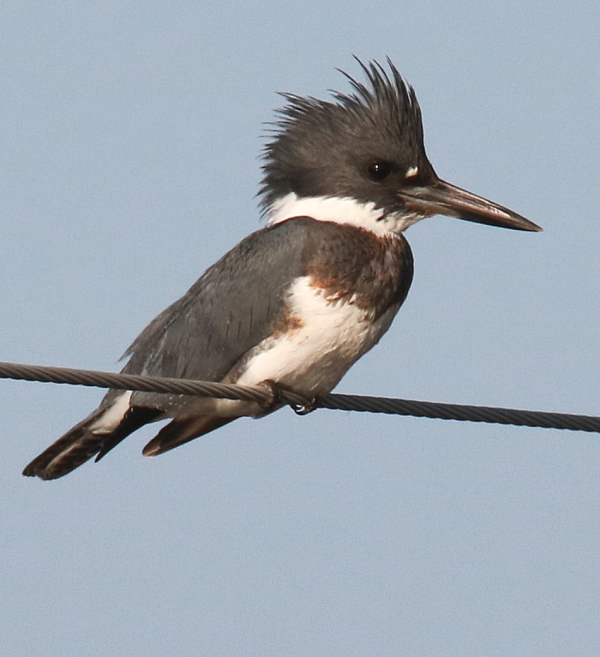You may have Belted Kingfishers in your area during the nesting season, and they do nest along the rivers up north here in Dakota, but only where there are river cutbanks where the kingfishers can excavate a nesting burrow. That rules this area of the Missouri Coteau out because there are no rivers, creeks, streams, or other flowing waterways – just a multitude of unconnected wetlands and lakes. But come mid-August I can always find a few Belted Kingfishers as they leave their nesting territories and hunt the edges of shallow prairie marshes in the area for small fish, dragonfly nymphs, and flying grasshoppers that mistakenly drop into the water.

Using an f7 aperture, the resulting shutter speed with an ISO of 400 ranged between 1/2000 and 1/2500, which is extra-fast for action photos, even for speeding Belted Kingfishers.
The period from mid-August through September is what I consider “kingfisher season” in these parts, and I take advantage of photographing the crowned birds when I find a trusting fisher king that allows me to approach within telephoto lens range. The past couple weeks I’ve had a young Belted Kingfisher that’s provided some OK photo ops that I’ve shared in recent Editor Afield articles, but my best opportunity came Sunday when a new first-fall kingfisher set up shop at a previously used kingfisher hunting area.

Flight photos provide a beautiful look at the feather shapes and colors, as well as the overall form of the bird in flight – with a variety of stages of flight – and gives you an insight into the mechanics of a flying bird.
|
I always try not to flush birds, edging ever-closer to get within a reasonable distance from the bird – essentially close enough to photograph it with a telephoto lens without scaring it. Sometimes, you can make a multiple-stage approach with a stop at a distance to let the bird become a bit familiar with you or your vehicle, then ease a little closer with reference to the direction of the sunlight.
This kingfisher was pretty trusting and let me park nearby as it searched for prey, took diving flights to try to catch small aquatic animals, and re-perched. Unfortunately, the only perch it used was a powerline wire that was suspended above the marsh, which is not an acceptable photo perch for me to share photos of with you, or anyone else. I draw the line on photographing birds on wires – usually. If you’re photographing a perched bird, it really should be perched on a natural branch or a perch that adds something rather than detracting from the photo. My friend Bill says, “But that’s what birds do – they perch on fences and wires and such,” but...
The Action Option
My concern for the wire perch left me with the option of concentrating on photographing action photos of the kingfisher in flight – as it took off from its perch during a hunting dive, or during its ascent from the water back to the wire. And that’s a good option, and one I like to concentrate on when possible, rather than a bird on a wire. I must admit though, Belted Kingfishers are charismatic-looking when the raise their broad crest, tip their tail up, and utter their rattling call. What kool birds, and they are so fast and active when they are not resting or searching for prey from a perch.
As soon as a motion on the water, or in the water catches their attention, their quick reaction is almost computeresque as they dive downward, or to one side or the other in a downward plunge. Usually there is a little flight time before the dive that requires a few wing flaps – wings up, wings down; repeat. But they are fast, and you must be ready – mentally, with quick reactions to their burst of energy; and physically as you try to follow their flight or dive above the water. If you’re really good, and really lucky, you may even be able to document their head-first plunge in a spray of water!

An action photo with a little blurring at the wing tips displays a level of motion that adds a bit of realism to still photos. But it’s important to keep the eyes in focus, because when the eyes are in focus the rest of the bird is usually in focus – the eyes, the bill, the tail, the feet.
|
I purposely began my birding drive early Sunday afternoon, about 4:30, hoping to get into position by the time the light was perfect, about an hour later. As I began photographing the young kingfisha, the sun was slightly on the harsh side, but it became better every 10 minutes until it was utterly perfect. My angle slightly to one side created a bit of a back shadow lower on the bird as it perched, but the light was fine when the kingfisher took flight.
As always, as soon as I was in position, I turned the engine off to eliminate vehicle vibrations, and rested my zoom lens against the frame of my window to steady it. I used my regular camera settings, which include using the aperture-preference setting (Av) and my standard f7 aperture when using my zoom or telephoto lenses. The resulting shutter speed using an ISO of 400 ranged between 1/2000 and 1/2500, which is extra-fast for action photos. Even so, the resulting flight photos show varied amounts of blurring at the wing tips, which doesn’t bother me because it shows a slight level of motion that adds a bit of realism to still photos. My main interest is keeping the eyes in focus, and with the f7 aperture, when the eyes are in focus the rest of the bird is in focus – the eyes, the bill, the tail, the feet.
As I photograph I try to remember to stay loose, because I tend to get my muscles tensed up from my shoulders to my feet, which I tend to brace against something, often the brake pedal. So I checked my body posture and loosened up, then realized I was sticking my tongue out my mouth, slightly; and when I pulled my tongue inside my mouth, I realized I was grinding my teeth – stop that. More importantly, I hold my breath in anticipation to photograph the bird, which keeps the camera and lens steadier.
I also try to lightly press down on my shutter release button when I do take a photo, but all that gets thrown out the window, so to speak, when the bird takes flight and I jerk the shutter button in a flash of reaction to the opportunity to try to take a photo of the kingfisher in racing flight. I try to take a few photos with each flight, sometimes with quick single photos, but you can increase your chances of getting more flight photos if you use the Al Servo setting on your camera, which allows your camera to take between 2 and 10 photos per second when you hold the shutter button down during the flight.
I try to keep my kool and follow the kingfisher’s rapid diving flight smooothly, but too often I tense up and follow the flight with a somewhat jerky motion – I tense up with excitement, and it’s just hard to follow the dart-like flight smoothly. Each flight is usually pretty brief and very rapid, so I take a few photos as the kingfisher dives, then try to get it back in focus as it flies upward to its elevated perch. Lately, the return flights haven’t been turning out very well, but the flights off the perch have produced some impressive flight photos, a few of which I share here.

Paul usually doesn’t like to share photos of birds perched on a wire, but this image shows a lot of the charisma kingfishers are known for, along with some of the details of its head and plumage. It’s great fun to try your hand at photographing kingfishers.
|
This was one of those lucky afternoons when I found a favored species that I enjoy photographing and made the most of the 40 minutes I shared in its company. It’s actually a goal I hope for each time I go birding – to find a trusting bird that will permit me to spend an extended period with it and photograph the resulting activities. And it’s a great feeling to be accepted by a bird, then drive away after photographing it without displacing it or altering its behavior. That’s always a good plan, but birds are mobile too, and they can take flight at the slightest whim or due to the loudest interruption.
Of course, you can find 3 species of kingfishers north of the Rio Grande in Texas, including the Belted, the larger Ringed Kingfisher and the smaller Green Kingfisher. But we are kingfisher poor in North America considering there are 118 species recognized worldwide. Luckily I have had a chance to observe and photograph many kingfisher species on the 6 continents they inhabit, and I must say a favorite is the little Malachite Kingfisher in Africa south of the Sahara, along with the Amazon Kingfisher in South America, and the Sacred Kingfisher in Australia – although don’t count out the Kookaburra either (the largest kingfisher). With that in mind, you should be able to find a kingfisher to photograph almost anywhere beyond Antarctica – in season. That is, during the “Kingfisher Season.”
Article and photos by Paul Konrad
Share your bird photos and birding experiences at editorstbw2@gmail.com